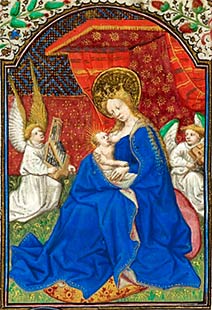
Virgin and Child from 'The Dunois Hours', c1450.
Exortum Est in Love and Lysse
(c.1450)
Nowell sing we, both all and some
Now Rex pacificus is come.
Exortum est in love and lysse.
Now Christ His grace He gan us gysse,
And with His body us bought to bliss,
Both all and some.
Nowell sing we, both all and some
Now Rex pacificus is come.
De Fructu ventris of Mary bright,
Both God and man in her alight,
Out of disease He did us dight,
Both all and some.
Nowell sing we, both all and some
De Fructu ventris of Mary bright,
Both God and man in her alight,
Out of disease He did us dight,
Both all and some.
Nowell sing we, both all and some
Now Rex pacificus is come.

Puer natus to us was sent,
To bliss us bought, fro bale us blent,
Both all and some.
Nowell sing we, both all and some
Now Rex pacificus is come.
Lux fulgebit with love and light,
In Mary mild His pennon pight,
In her took kind with manly might,
Both all and some.
Nowell sing we, both all and some
Now Rex pacificus is come.
Gloria Tibi ay and bliss,
God unto His grace He us wysse,
The rent of heaven that we not miss,
Both all and some.
Nowell sing we, both all and some
Now Rex pacificus is come.

The photographs are of Canterbury Cathedral.

Puer natus to us was sent,
To bliss us bought, fro bale us blent,
Both all and some.
Nowell sing we, both all and some
Now Rex pacificus is come.
Lux fulgebit with love and light,
In Mary mild His pennon pight,
In her took kind with manly might,
Both all and some.
Nowell sing we, both all and some
Now Rex pacificus is come.
Gloria Tibi ay and bliss,
God unto His grace He us wysse,
The rent of heaven that we not miss,
Both all and some.
Nowell sing we, both all and some
Now Rex pacificus is come.

The photographs are of Canterbury Cathedral.







